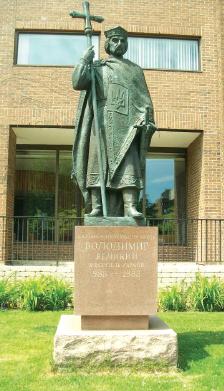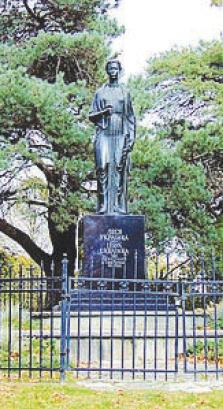Ukrainian
Canadians: 200 Years of History – Highly Organized Community
By
Andrew Gregorovich
The following excerpt is the continuation
of a lecture delivered by Andrew Gregorovich at St. Vladimir Institute, Toronto,
in October 2011
in celebration of Ukrainian
settlement in Canada.
Previous excerpts were printed in The New Pathway on the War of 1812 and the
Ukrainian community’s pre-history in North
America before 1891, and on the four waves
of immigration to Canada.
Ukrainian Canadians are a highly organized
community with hundreds of organizations across the country coordinated by the
Ukrainian Canadian Congress. The Taras Shevchenko Foundation in Winnipeg
has supported Ukrainian culture in Canada
with millions of dollars in grants.
The Canadian Institute of
Ukrainian Studies (CIUS) located at the University
of Alberta
and the University
of Toronto
has published a substantial number of books relating to Ukraine
and its history.
The Ukrainian Catholic
and the Ukrainian
Orthodox
Churches
in Canada
actively contribute to the spiritual and cultural life of the community. Many
cities across Canada
have Ukrainian churches distinguished by the architecture of their distinctive
baroque cupolas and their three bar, diagonal bottom bar, Ukrainian Cross.
 The Ukrainian press,
books and bookstores in Canada
have played an important role in preserving the Ukrainian language and heritage
since 1902. There are Ukrainian libraries and museums in cities like Toronto,
Winnipeg,
Saskatoon,
Edmonton,
Calgary,
Montreal
and Vancouver.
Toronto
has a Taras
Shevchenko
Museum
on Bloor St. West
and I established there the world’s first Shevchenko internet site on
Infoukes.
The Ukrainian press,
books and bookstores in Canada
have played an important role in preserving the Ukrainian language and heritage
since 1902. There are Ukrainian libraries and museums in cities like Toronto,
Winnipeg,
Saskatoon,
Edmonton,
Calgary,
Montreal
and Vancouver.
Toronto
has a Taras
Shevchenko
Museum
on Bloor St. West
and I established there the world’s first Shevchenko internet site on
Infoukes.
Across Canada
many monuments and historical plaques have been erected to preserve the
Ukrainian experience in Canada.
For example, there is a large Ukrainian pioneer monument in front of the
Alberta Legislature and one at Hamilton
City Hall.
The “world’s biggest pysanka” (Ukrainian Easter Egg)) is in Vegreville,
Alberta
and is on a 2009 Canadian postage stamp. The huge Ukrainian
Cultural
Heritage
Village,
East of Elk Island National Park in Alberta
is an impressive tourist attraction with its many Ukrainian buildings from the
early 1900s. There is a monument of the great Ukrainian national poet Taras
Shevchenko on the Manitoba Legislature grounds in Winnipeg
and another Shevchenko monument in Ottawa.
A Lesia Ukrainka monument is in Toronto’s
High
Park.
There are many other Ukrainian monuments across Canada.
Ukrainian Canadian plaques are in the Ontario Legislature and in the National
Library of Canada.
Toronto
first attracted Ukrainians a century ago in 1900. However, the first Ukrainian
Torontonian was probably Charles George Horetzky who came in the 1880s. He
built a home in Toronto
which is still standing on Bedford
Rd north of Bloor and I
designated it a Toronto
historical site when I was Chairman of the Toronto Historical Board. I also
designated St Josaphat’s Cathedral as a Toronto
historical site with a plaque because it is the oldest Ukrainian building in
the city.
Now Ukrainians number
over 100,000 and are concentrated in West Toronto
and Mississauga.
The community has over 150 organizations to serve its social, spiritual,
educational, economic, and cultural needs. In addition to two dozen churches
there are credit unions, cultural centers and other buildings serving the
community. For example, the St. Vladimir Institute at 620
Spadina Ave., which has a statue of
King Volodymyr the Saint in front, is a university student residence. It has a
library and a museum. The Ukrainian National Federation is on Evans
Ave. and has the oldest
Ukrainian library. The Ukrainian Cultural Centre on Christie
St. is a major hall of the
League of Ukrainian Canadians. The community has two Ukrainian bookstores Koota
Ooma and Bukva. Ukrainians have been important in Toronto
business. For example, George Cukornyk was a co-founder of the Harvey’s
hamburger chain.
 The Ukrainian World
Congress and the World Federation of Ukrainian Women’s Organizations have their
headquarters in Toronto
at the UNF Hall on Evans Ave.
A wonderful monument
of Ukrainian
poetess Lesia Ukrainka is in the middle of High
Park.
There is a historical plaque on the Canadian National Exhibition grounds on the
street in front of the Stanley Barracks marking the internment of over 5,000
Ukrainian Canadians in WWI. There is a Ukrainian
Canadian
Memorial Park
at Eglinton Ave.
and Scarlett Rd.
where the community commemorates Remembrance Day every November. Every year
there are two festivals: The Ukrainian Canadian Congress celebrates Ukraine’s
August 24, 1991
Independence Day in Centennial
Park.
The Bloor West Village Toronto Ukrainian Festival, organized by Jurij Klufas,
is the largest Ukrainian street
festival in North America
and is celebrated in September.
The Ukrainian World
Congress and the World Federation of Ukrainian Women’s Organizations have their
headquarters in Toronto
at the UNF Hall on Evans Ave.
A wonderful monument
of Ukrainian
poetess Lesia Ukrainka is in the middle of High
Park.
There is a historical plaque on the Canadian National Exhibition grounds on the
street in front of the Stanley Barracks marking the internment of over 5,000
Ukrainian Canadians in WWI. There is a Ukrainian
Canadian
Memorial Park
at Eglinton Ave.
and Scarlett Rd.
where the community commemorates Remembrance Day every November. Every year
there are two festivals: The Ukrainian Canadian Congress celebrates Ukraine’s
August 24, 1991
Independence Day in Centennial
Park.
The Bloor West Village Toronto Ukrainian Festival, organized by Jurij Klufas,
is the largest Ukrainian street
festival in North America
and is celebrated in September.
The Government of Ontario
in 2009 unanimously recognized the 1932-33 Holodomor Famine in Ukraine
perpetrated by Stalin and Kaganovich as genocide. The Government of Ontario
also unanimously established Ukrainian Heritage Day on September 7 and the
first one was held in 2011. Steve Peters, of Ukrainian ancestry, is the Speaker
of the Ontario Legislative Assembly and participated.
Ukrainian culture is
represented in Toronto
by many choirs and folk dance groups. Christmas is celebrated by many Ukrainian
Torontonians on January 7 by the old Julian calendar preceded by a 12 dish
[holy dinner] Sviata Vechera the previous day. Carolers visit many homes
and collect donations for church and other organizations to help finance their
activities. Easter by the same calendar varies from the ordinary date usually
from the same date to one month later depending on church calculations. On
Easter morning families bring a basket of food for blessing which many decorate
with exquisite miniature works of art, the Ukrainian Easter Eggs known as pysankas.
The Ukrainian Canadian
community is a highly organized community and has had considerable influence in
Ukraine’s
early independence. Many Ukrainian Canadians were advisors to the Government of
Ukraine. Our research information, for instance, on the 1932-1933 Holodomor
Ukrainian Famine Genocide with millions of victims perpetrated by Stalin and
Lazar Kaganovich, has been valuable to Ukraine.
Ukrainian President Leonid Krawchuk once told me that it was thanks to
Ukrainians in Canada
that the memory of the Famine Genocide was preserved.
In conclusion, we cay say
that Toronto
has one of the most dynamic and powerful Ukrainian communities in the world and
is a twin city of Kyiv,
the capital of Ukraine.
Andrew Gregorovich is a Librarian Emeritus
of the University
of Toronto.
Currently, he is President of the Taras
Shevchenko
Museum
in Toronto,
and President of the Ukrainian Librarians Association. He is also former
Executive Director of the Ukrainian Canadian Research & Documentation
Centre, former Chairman of the Toronto
Historical Board, and a past President of the Ontario
Library Association.
The last in a series of excerpts of Andrew
Gregorovich’s lecture Ukrainian Canadians: 200 Years of History … will appear
later this summer as the year celebrating the 120th Anniversary of
Ukrainian Settlement in Canada
(1891-2011) comes to a close.
PHOTOS
1 - Monument of Volodymyr the Great
in Toronto
2 - Monument of Ukrainian poetess Lesia Ukrainka in High Park, Toronto
The Ukrainian press,
books and bookstores in
The Ukrainian World
Congress and the World Federation of Ukrainian Women’s Organizations have their
headquarters in